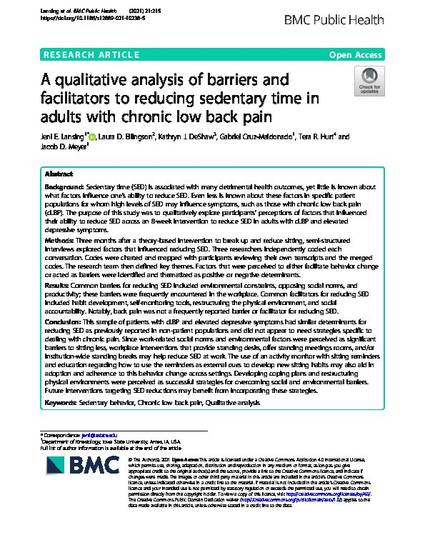
Background
Sedentary time (SED) is associated with many detrimental health outcomes, yet little is known about what factors influence one’s ability to reduce SED. Even less is known about these factors in specific patient populations for whom high levels of SED may influence symptoms, such as those with chronic low back pain (cLBP). The purpose of this study was to qualitatively explore participants’ perceptions of factors that influenced their ability to reduce SED across an 8-week intervention to reduce SED in adults with cLBP and elevated depressive symptoms. Methods
Three months after a theory-based intervention to break up and reduce sitting, semi-structured interviews explored factors that influenced reducing SED. Three researchers independently coded each conversation. Codes were charted and mapped with participants reviewing their own transcripts and the merged codes. The research team then defined key themes. Factors that were perceived to either facilitate behavior change or acted as barriers were identified and thematized as positive or negative determinants. Results
Common barriers for reducing SED included environmental constraints, opposing social norms, and productivity; these barriers were frequently encountered in the workplace. Common facilitators for reducing SED included habit development, self-monitoring tools, restructuring the physical environment, and social accountability. Notably, back pain was not a frequently reported barrier or facilitator for reducing SED. Conclusion
This sample of patients with cLBP and elevated depressive symptoms had similar determinants for reducing SED as previously reported in non-patient populations and did not appear to need strategies specific to dealing with chronic pain. Since work-related social norms and environmental factors were perceived as significant barriers to sitting less, workplace interventions that provide standing desks, offer standing meetings rooms, and/or institution-wide standing breaks may help reduce SED at work. The use of an activity monitor with sitting reminders and education regarding how to use the reminders as external cues to develop new sitting habits may also aid in adoption and adherence to this behavior change across settings. Developing coping plans and restructuring physical environments were perceived as successful strategies for overcoming social and environmental barriers. Future interventions targeting SED reductions may benefit from incorporating these strategies.
Available at: http://works.bepress.com/jacob-meyer/20/

This article is published as Lansing, J.E., Ellingson, L.D., DeShaw, K.J. et al. A qualitative analysis of barriers and facilitators to reducing sedentary time in adults with chronic low back pain. BMC Public Health 21, 215 (2021). https://doi.org/10.1186/s12889-021-10238-5.